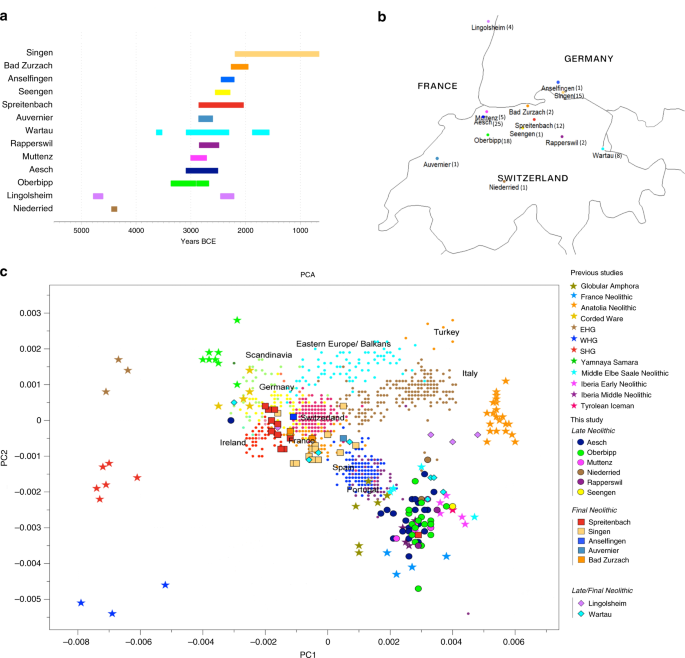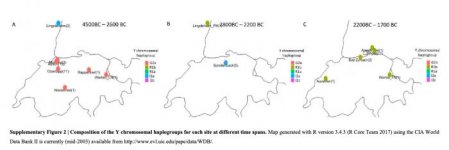I Agree. There was definitely some form of caste involved. I think Indian style caste-system is maybe a little different because it still exists today and is unique to India and the autosomal impact is rather small. To me this looks like "Colonization" similar to what the Spanish did in the Americas and it is clear that the Spanish were not very peaceful to the natives.
Here is an interesting paper about this time:
https://www.cambridge.org/core/jour...Tw5_LYUnw8YvQzm-w3kL6GIc0NWALi4LC2iLgFPdrN6A#
Again, like the last paper about the early polish CWC. Light eye colour goes down when the steppe people arrive. Light eye colour and hair colour really look like traits of the neolithic farmers of Europe.
Yes, we're in agreement about that. The only mass migration I can think of off hand where a "local" male haplogroup was adopted and flourished was with the Anatolian farmers, although G2a2 certainly took over in the Near East. Perhaps there just weren't enough of them in the beginning and they needed strong backs to do the farming. Also, although there is always, in my opinion, a certain level of "class" distinction in human societies, it was nothing to what happened later with the accumulation of agricultural surplus, and then the invention of metals.
I think we shouldn't underestimate the other factors, however, like prior population levels, and the effect of disease in decimating the native population, as we saw in the New World. Even those who survived would have been weakened and traumatized.
Think of more recent invasions. The Romans conquered most of their known world, killing and enslaving a lot of people in the process, so they were by no means saints, but they had no interest in exterminating all the males or creating a permanent caste system. Once the "natives" accepted they were now part of the empire, they were gradually enfranchised, and their local elites, the local social structure remained intact. They just wanted the trade and the taxes. Of course, population levels were high, and in the beginning there was no plague, although plagues hit later, but they affected all equally.
So, the lack of inclusiveness would have differed depending on the particular group involved and their situation. The Langobards were worse than the Goths, and imposed a caste system which lasted for almost a thousand years, but they didn't have the plague to help them and preceding population levels were higher, plus they were much fewer in number and the fields had to be tilled, so the y Dna change was much less. The Scythians were much more inclusive * than the Sarmatians etc. for reasons we may never know. The Huns were perhaps the worst of all? Of course they killed a huge percentage of the women as well, totally depopulating certain areas.
A depressing picture indeed.
As for the light eye and hair color, I remember when the first report was issued of the Corded Ware warrior in Poland, indicating he was "much darker" than modern Poles, and the howls of protest.
I'm not quite sure I'd say the light hair and eyes combination were the predominant trait of the Neolithic farmers of Europe. It certainly isn't true of the first arrivals from Anatolia, although there were some light eyed people among them, perhaps from their minority substrate of Balkan type HG? There were some light haired and eyed people among the SHG as well, and the EHG had a lot of SLC45A2 which further lightened the skin, although they were still brown eyed and haired, or at least a good number of them were** . Somehow, and for some reason the combination did come together in Europe. Perhaps it was in Globular Amphora, or perhaps in more northern regions among people incorporated by steppe people. It's still murky to me how and why it rose to prominence, but I think the idea that the steppe people brought it to Europe can be laid to rest. Instead, they picked it up in Europe and then brought it back out east with them. So, those "lighter" Andronovo people used as "proof" of the fairness of the steppe people was incorrect.
Dear, dear, first milk drinking and then blonde hair and blue eyes aren't signs of the "superior" Aryans. If Hitler had been freeze dried and resurrected he'd shoot himself in despair. Goebels and that monster wife of his as well. She even killed her own children, so she'd have no problem with it. I just read somewhere that Hitler, Goebbels and Himmler had thought about perhaps exterminating all dark haired people. I guess it had been a while since he had looked in a mirror and actually "seen" himself. What is it about us as human beings that we let such mad men rule us?
Ed.
*corrected to say inclusive, although I'm sure our members knew that.
**further clarification





